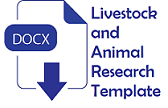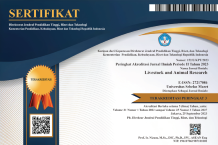Inventarisasi potensi emisi metana (CH4) pada peternakan sapi perah di Kecamatan Pujon, Kabupaten Malang
Abstract
Objective: The methane emissions in ruminants such as dairy cows was one of the causes of climate change. The aimed of this study was to make an inventory of methane emissions from dairy farms in Pujon District. The methane emission data inventory was expected to assist the government in making policies as an effort to mitigation of methane emissions.
Methods: The secondary data used in this study were obtained from journals, books, literature related to research, and data from the Central Statistics Agency (BPS). Methane emissions was calculated using the Tier 1 method according to IPCC reference. The reason for the inventory using the tier 1 method was caused that the specific data related to emissions on dairy cows in Malang Regency were not available. The data obtained were processed descriptively.
Results: The data obtained shown that the population of dairy cows in Pujon District from 2013-2015 has increased, in 2016 it experienced a significant decline, namely 14.2%, then from 2017-2019 it continued to decline. Methane emissions from enteric fermentation from 2013-2019 averaged 23.13 Gg CO2-eq / year. Methane emissions from manure management in dairy cows in Pujon District from 2013-2019 were an average of 11.75 Gg CO2-eq / year. The highest methane emissions were in 2015, and the lowest was in 2019.
Conclusions: Based on the results of the study, it can be concluded that methane emissions from dairy cows in Pujon District increased from 2013-2015, there was a significant reduction in emissions in 2016 – 2019. Feeding with balanced nutrients, using ingredients of concentrated and forage containing good nutrients quality is an effort to mitigate methane that can applied by farmers.Keywords
Full Text:
PDF (Bahasa Indonesia)References
- Nugrahaeningtyas E., C. Y. Baek, J. H. Jeon, H. J. Jo, and K. H. Park. 2018. Greenhouse gas emission intensities for the livestock sector in Indonesia, based on the national specific data. Sustainability. 10(6): 1-15. Doi: 10.3390/su10061912
- Ferner, J., S. Schmidtlein, R. T. Guuroha, J. Lopatin, and A. Linstädter. 2018. Disentangling effects of climate and land-use change on West African drylands’ forage supply. Glob. Envir. Change. 53:24-38. Doi: 10.1016/j.gloenvcha.2018.08.007
- Thornton, P. K., J. Van de Steeg, A. Notenbaert, and M. Herrrero. 2009. The impacts of climate change on livestock and livestock systems in developing countries: a review of what we know and what we need to know. Agric. Syst. 101:113-127. Doi: 10.1016/j.agsy.2009.05.002
- Nardone, A., B. Ronchi, N. Lacetera, M. S. Ranieri, and U. Bernabucci. 2010. Effects of climate change on animal production and sustainability of livestock systems. Livest. Sci. 130:57–69. Doi: 10.1016/j.livsci.2010.02.011
- Bernabucci, U. 2019. Climate change: impact on livestock and how can we adapt. Anim. Front. 9(1):3-5. Doi: 10.1093/af/vfy039
- Rojas-Downing, M. M., A. P. Nejadhashemi., T. Harrigan., and S. A. Woznicki. 2017. Climate change and livestock: impacts, adaptation, and mitigation. Clim. Risk Manag. 16:145–163. Doi: 10.1016/j.crm.2017.02.001
- Hervani, A. dan M. Ariani. 2019. Emisi metana dari pengelolaan kotoran ternak di Yogyakarta - inventarisasi. Jurnal Peternakan Indonesia. 21(3): 319-326. Doi: 10.25077/jpi.21.3.319-326.2019
- Badan Pusat Statitistilk (BPS) Provinsi Jawa Timur. Populasi sapi perah menurut kabupaten/kota di Jawa Timur, 2009-2017 (ekor) [Internet]. BPS, c2018 [Cited 2020 Sep 17]. Available from: https://jatim.bps.go.id/statictable/2018/10/18/1292/populasi-sapi-perah-menurut-kabupaten-kota-di-jawa-timur-2009-2017-ekor-.html
- Intergovernmental Panel on Climate Change (IPCC). 2006. Guidelines for national greenhouse gas inventories – a primer. IGES, Kanagawa
- Kementrian Lingkungan Hidup (KLH). 2012. Pedoman penyelenggaraan inventarisasi gas rumah kaca nasional. Buku II Volume 3. Kementrian Lingkungan Hidup Press, Jakarta.
- Karakurt, I., G. Aydin, and K. Aydiner. 2012. Sources and mitigation of methane emissions by sectors: a critical review. Renew. Energy. 39:40-48. Doi: 10.1016/j.renene.2011.09.006
- Gerber, P. J., H. Steinfeld, B. Henderson, A. Mottet, C. Opio, J. Dijkman, A. Falcucci, and G. Tempio. 2013. Tackling climate change through livestock: a global assessment of emissions and mitigation opportunities. FAO, Rome.
- Ichdayati, I. I., E. Dwiningsih, dan R. K. Putri. 2019. Keseimbangan harga dan kuantitas pasar susu segar di indonesia. Agricore: Jurnal Agrikultur dan Sosial Ekonomi Unpad. 4(20): 23-36.
- Adiwibowo, H. dan Feryanto. 2014. Daya saing usaha ternak sapi perah rakyat di Kecamatan Pujon Kabupaten Malang Jawa Timur. Media Ekonomi. 22(1): 73-96.
- Akhadiarto, S. dan M. N. Rofiq. 2017. Estimasi emisi gas metana dari fermentasi enterik ternak ruminansia menggunakan metode TIER-1 di Indonesia. Jurnal Teknologi Lingkungan. 18(1):1-8. Doi: 10.29122/jtl.v18i1.38
- Badan Pusat Statistik (BPS). Populasi Sapi Perah menurut Provinsi, 2009-2019. [Cited 2020 Sep 17]. Available from: https://www.bps.go.id/indicator/24/470/1/populasi-sapi-perah-menurut-provinsi. html
- Dhia, K. S., M. Umar, G. Mahesti, dan A. Purnomoadi. 2015. Potensi cemaran nitrogen ke udara dari feses sapi potong dengan level protein intake yang berbeda. Prosiding Seminar Nasional Teknologi Peternakan dan Veteriner. 2015:306-311.
- Prima, A., E. Purbowati, E. Rianto, and A. Purnomoadi. 2019. The effect of dietary protein levels on body weight gain, carcass production, nitrogen emission, and efficiency of productions related to emissions in thin-tailed lambs. Vet. World. 12(1):72-78. Doi: 10.14202/vetworld.2019.72-78
- Menezes, A. C. B., S. C. V. Filho, L. F. C. Silva, M. V. C. Pacheco, J. M. V. Pereira, P. P. Rotta, and L. N. Renno. 2016. Does a reduction in dietary crude protein content affect performance, nutrient requirements, nitrogen losses, and methane emissions in finishing Nellore bulls? Agric. Ecosyst. Environ. 223:239-249. Doi: 10.1016/j.agee. 2016.03.015
- Patra, A., T. Park, and M. Kim. 2017. Rumen methanogens and mitigation of methane emission by anti-methanogenic compounds and substances. J. Anim. Sci. Biotechnol. 8(1):1-8. Doi: 10.1186/s40104-017-0145-9
- Garg, M. R., P. L. Sherasia, B. M. Bhanderi, B. T. Phondba, S. K. Shelke, and H. P. S. Makkar. 2013. Effects of feeding nutritionally balanced rations on animal productivity, feed conversion efficiency, feed nitrogen use efficiency, rumen microbial protein supply, parasitic load, immunity and enteric methane emissions of milking animals under field conditions. Anim. Feed Sci. Technol. 179: 24-35. Doi: 10.1016/j.anifeedsci.2012.11.005
- Boadi, D., C. Benchaar, J. Chiquette, and D. Massé. 2004. Mitigation strategies to reduceenteric methane emissions from dairy cows: update review. Can. J. Anim. Sci. 84:319-335.
- Permana, I. G., Suryahadi, dan E. Qurimanasari. 2012. Greenhouses gases emissions from dairy cattle in Indonesia. Proc. 2nd Intl. Seminar on Anim. Indones. 2012: 203-207.
- Wahyono, T. dan Y. Widiawati. 2019. Emisi gas rumah kaca dari sapi perah di Indonesia. In: Aldrian E., S. Puspowardoyo, dan B. Haryanto, editor, Emisi gas rumah kaca dari peternakan di Indonesia dengan metode TIER 2 IPCC. LIPI Press, Jakarta. p. 29-42.
- Gerber. P. J., A. N. Hristov, B. Henderson, H. Makkar, C. Oh, R. Lee, F. Meinen, T. Montes, J. Ott, A. Firkins, C. Rotz, A. T. Dell, W. Z. Adesogan, J. M. Yang, G. Tricarico, J. Waghorn, Dijkstra, and S. Oosting. 2013. Technical options for the mitigation of direct methane and nitrous oxide emissions from livestock: a review. Animal. 7(2):220-234. Doi: 10.1017/S1751731113000876
- Black, J. L., M. Thomas, Davison, and B. Ilona. 2021. Methane emissions from ruminants in Australia: mitigation potential and applicability of mitigation strategies. Animal. 11(4):1-20. Doi: 10.3390/ani11040951
Refbacks
- There are currently no refbacks.










